Some muscles are easier to isolate than others. Your biceps come to the party every time you perform a row or pull-up whether you like it or not, after all.
When it comes to building your legs, you’d be hard-pressed to perform a squat variation that doesn’t put your quads through the ringer, and the same idea holds true for your hamstrings and their involvement in all manner of deadlift.
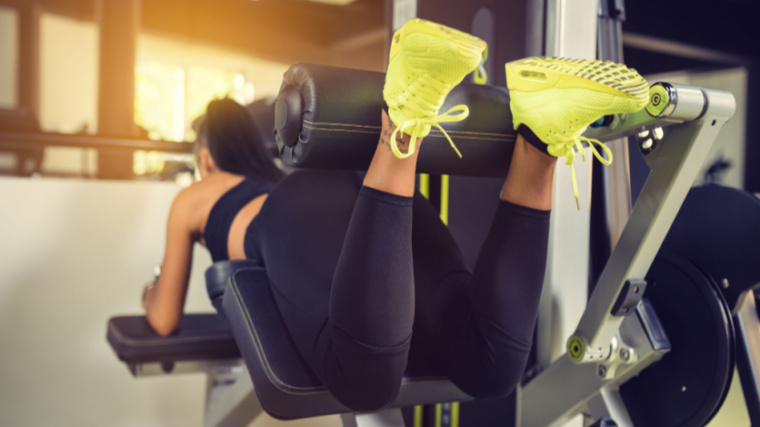
Isolating the back of your thighs isn’t as simple and isn’t easily achieved with a barbell, that’s for sure. Enter the lying, or prone, leg curl — your isolation-based answer to building up your hammies and developing strong, powerful legs.
Here’s the skinny on how the lying leg curl helps you get beefy.
- How to Do the Lying Leg Curl
- Lying Leg Curl Sets and Reps
- Common Lying Leg Curl Mistakes
- Lying Leg Curl Variations
- Lying Leg Curl Alternatives
- Muscles Worked by the Lying Leg Curl
- Benefits of the Lying Leg Curl
- Who Should Do the Lying Leg Curl
- Frequently Asked Questions
Editor’s Note: The content on BarBend is meant to be informative in nature, but it should not be taken as medical advice. When starting a new training regimen and/or diet, it is always a good idea to consult with a trusted medical professional. We are not a medical resource. The opinions and articles on this site are not intended for use as diagnosis, prevention, and/or treatment of health problems. They are not substitutes for consulting a qualified medical professional.
How to Do the Lying Leg Curl
There’s more to the lying leg curl than simply lying down and curling your legs — but not by much, so don’t fret.
However, your equipment selection will greatly impact both the practicality and efficacy of this exercise. If you train at home, you’ll probably have to perform the movement with a resistance band.
Most commercial gyms will have an exercise machine specifically dedicated to the movement. The lying, or prone, leg curl machine will generally be your best bet to get the most bang for your buck.
Step 1 — Adjust the Machine
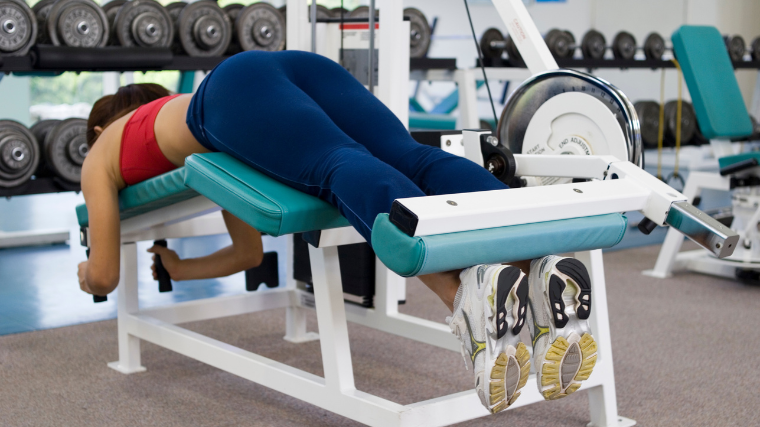
Your first step is to make sure the machine is aligned with your body. Adjust the height and distance of the pad so it matches the proportions of your legs. The pad should be set low enough that your leg is straight when in contact with it. It should also rest right on the back of your shins, atop your Achilles tendons.
Coach’s Tip: You should feel a mild stretch in your hamstrings when set up in the machine if the pad is in the correct place.
Step 2 — Curl and Squeeze
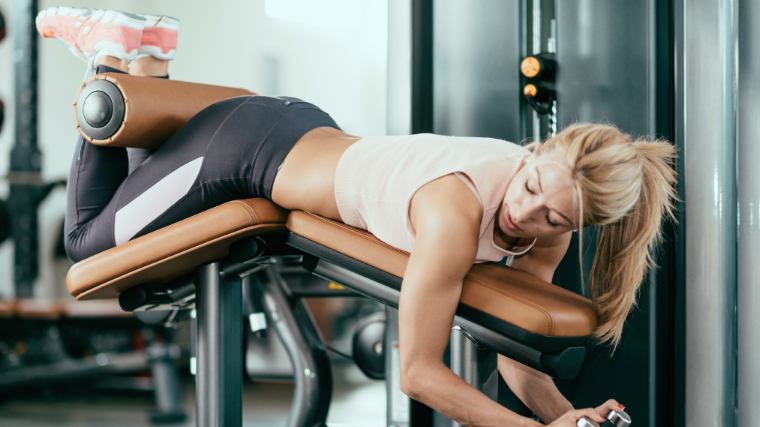
Once your leg is securely locked against the pad, grab the handles or hold onto the torso rest itself and curl your leg up until your shin is at least 90 degrees with your upper thigh.
Coach’s Tip: As you bring your leg up, push your hips into the pad.
Lying Leg Curl Sets and Reps
As with just about every exercise under the sun, how you program it will strongly affect the results you glean.
- For Muscular Endurance: Try 3 to 4 sets of as many as 15 reps with limited rest.
- As a Beginner: Start simple with 3 sets of 10 reps.
- For Muscle Growth: Train hard with 2 to 4 sets of 8 to 12 reps and a moderately-heavy weight.
Note: If you choose to perform the lying leg curl with a resistance band, consider upping your total rep count to accommodate the lower level of potential load.
Common Lying Leg Curl Mistakes
Generally speaking, the lying leg curl (and most machine exercises) are hard to mess up. Many stations also provide written instructions as well. However, there are some specific technical elements you should pay mind to while you’re working your hammies.
Rushing the Movement
If you’re doing your prone leg curls on an exercise machine, the torso pad can provide you with a great deal of extra leverage. Leverage is all well and good for building a lot of strength, but it does defeat the purpose of isolating your hamstrings if you use the pad to involve other muscles.
Make sure that you aren’t using the structure of the machine itself to turn the exercise into something it’s not. Take it slow and steady and try to apply the tension directly where it belongs — on the back of your legs.
Lifting Your Hips
Whether you’re using a machine or working on the floor with a band, one of the biggest technique no-no’s of the prone curl is involving your hips.
It can be all too tempting to lift your butt off the pad (or ground) and go into a small kneeling position. This helps you lift more weight, but at the cost of some hamstrings recruitment.
Keep your hips firmly locked out by squeezing your glutes for the duration of your set to ensure that this isolation movement, well, isolates things.
Lying Leg Curl Variations
You can only tweak and tailor this exercise so much before it becomes something else. That said, there are some adjustments to the standard lying leg curl that merit a mention.
Banded Lying Leg Curl
If you don’t have access to a leg curl station (because you exercise at home or for some other reason — a machine-hogging gymgoer certainly counts) you can substitute the machine’s resistance for an exercise band instead.
Fixing a thick resistance band to a low pillar of some kind will allow you to perform the exercise, but at the cost of an inconsistent resistance profile and some clumsy setup. It works in a pinch, but it’s not ideal.
Single-Leg Lying Leg Curl
The beauty of exercise machines is in how they remove many of the elements that make resistance training so challenging, such as the stability demand.
If you have a muscular imbalance or simply want to give your hammies the most focused, dedicated attention possible, simply perform the lying leg curl with one leg at a time.
You don’t even need to place the heel of your working leg in the middle of the machine’s pad — the resistance will apply just fine if you simply leave your working leg where it would otherwise be.
Lying Leg Curl Alternatives
In the absence of a resistance band or the machine itself, you can still isolate your hamstrings for strength and growth. Try out one of these alternatives if you’re in doubt.
Nordic Curl
For a bodyweight movement, the Nordic leg curl is extremely challenging. It also happens to be a phenomenal hamstring builder.
https://youtube.com/watch?v=k3R6LCLxAJs
You’ll need a workout partner or some other way to secure your feet so you don’t topple over. But you can use the Nordic curl to overload your hamstrings in a pinch. This exercise is deceptively challenging, so take it easy to begin with.
If you’ve never done it before, expect to only get a handful of reps at best.
Glute-Hamstring Developer (GHD)
Most gyms will have a GHD, or glute-hamstring developer, station somewhere. The machine does exactly what its name alludes to, and you can use it to replicate the leg curl as well.
This machine simply changes the orientation of your body from horizontal to vertical while you use the weight of your torso as resistance. It’s harder than it looks, and it works just fine for isolating your hammies.
Good Morning
One of the best parts of the lying hamstring curl is that it lets you train your hamstrings without having to go ultra-heavy, as you would in the deadlift.
So, you can work with a barbell and still accomplish this goal, to a degree, by using the good morning. The good morning is a hip hinge that is very similar to the deadlift in form and posture.
But by placing the load high up on your back instead of in your hands, a low amount of resistance ends up feeling quite heavy on your legs.
Muscles Worked by the Lying Leg Curl
It’s no big mystery — the lying leg curl is a hamstring exercise through-and-through. However, a closer examination of your anatomy can help you understand how your hamstrings work and why this movement in particular is so effective.
Hamstrings
Your hamstrings are both simple and complex. They’re a biarticular muscle, meaning they cross two joints at once — your knee and hip. Their primary function is to either bend your knee while your hip is straightened, or flex the hip while your knee is straightened.
This unique design makes them hard to train properly through movements like the squat; if both the knee and hip are flexed at the same time, there simply won’t be much of a stretch on the tissue.
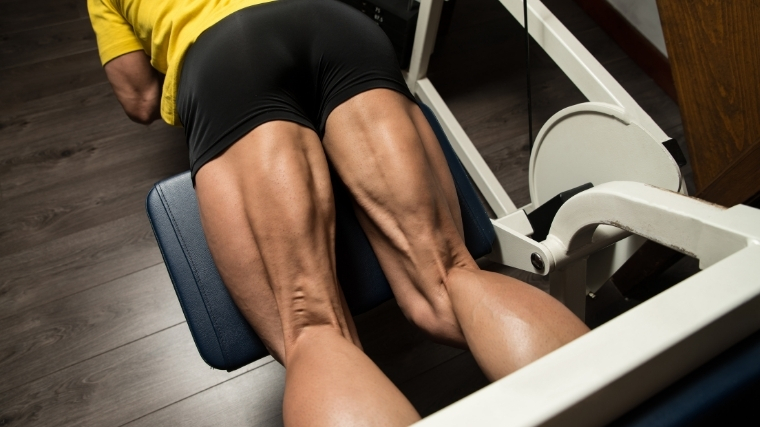
So, you can hinge at the hip and torch your hammies through moves like the good morning or stiff-legged deadlift, but doing the opposite isn’t as easy.
Luckily, exercise machines allow you to load the knee-flexion function of your hamstrings safely, without having to utilize gravity to create resistance. This is why the prone hamstring curl is a borderline-irreplaceable movement for your hamstrings — gravity simply wouldn’t let you get it done with a free weight.
Benefits of the Lying Leg Curl
In addition to providing you an avenue to stimulate and develop your hams, the lying leg curl also brings with it a swath of other benefits.
Targeted Hamstring Stimulation
You can — and should — use the lying leg curl to apply direct tension to the back of your thighs, especially if you want to do so without using heavy weights.
While other exercises, particularly compound movements, tax the hammies just fine, they also require you to stabilize heavy loads or involve other muscle groups. The prone hamstring curl lets you put all the tension where it belongs to maximize growth.
May Reduce Knee Injury Rates
If you’re prone to knee ailments or practice a sport that beats up your knees, you may want to think about adding the prone hamstring curl into your regimen.
It’s far from conclusively proven, but some literature has documented that hamstring exercises with an emphasis on eccentric tension to be an effective way of modulating knee injury risk. (1)
This could be due to the fact that the hamstrings help control the rate at which your knee bends. Stronger hamstrings might help provide more robust stability and control to the joint during unstable activities or dynamic action.
Since you most often perform the prone hamstring curl on an exercise machine, you can directly control how fast your knee opens via a slow tempo.
Easy to Learn
If you’re new to the gym, there’s no harm or shame in starting with low-level straightforward exercises. Training is intimidating enough on its own, so an easy-to-learn exercise like the lying hamstring curl can be a great way to get your feet wet with lower-body resistance training.
Who Should Do the Lying Leg Curl
If you have the machine in your gym (or a resistance band on-hand), you should probably consider giving the lying leg curl a go. There’s probably a reason to have it in your workout in some capacity.
Beginners
Newer gymgoers are prime candidates for the lying leg curl. Early on into your gym career, the last thing you want to do is accidentally neglect a muscle group.
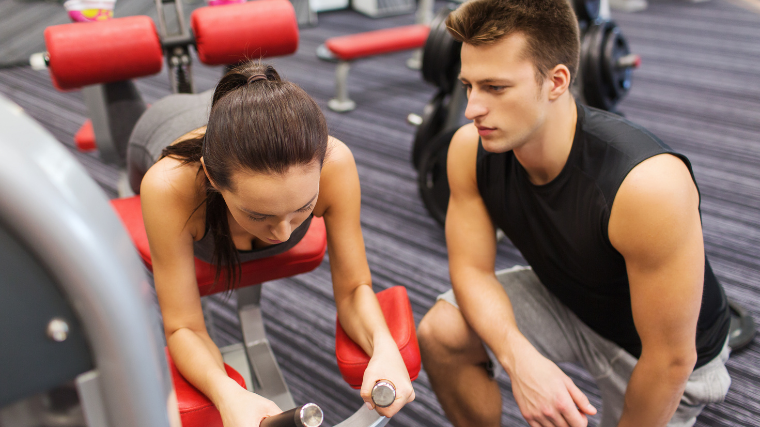
Proportional, balanced development is crucial, so you can (and should) utilize machine isolation exercises in some capacity to target muscles you may struggle to adequately train through “bigger” movements.
Bodybuilders
Muscle growth is all about finding the right tool for the job. For you as a bodybuilder, the right tool is often the one that lets you put the most mechanical tension on the tissue to elicit hypertrophy.
The lying leg curl accomplishes this in spades, and is an invaluable asset if you’re trying to grow your hammies specifically.
Strength Athletes
It can be difficult to stimulate your hamstrings if you’re a strength athlete. Heavy pulls are all well and good, but shouldn’t be a requirement for targeting the tissue.
Some light lying hamstring curls can serve as an effective element of a prehab circuit or help to warm your knees up before a heavy squat workout. Lightly pumping up your hams may even make it more comfortable to sit into the bottom of a deep squat by way of added cushioning.
Roast Your Hams
You don’t need big, bullish exercises to build muscle — even if those muscles are as large and powerful as your hamstrings.
The targeted, progressible, easy-to-access lying hamstring curl is an excellent tool for the physique enthusiast and dedicated strength athlete alike. For your average gymgoer, it’s just an easy, breezy way to ensure you’re training every muscle in your legs.
There’s basically no downside to building up your backside, other than maybe struggling to find pants that fit.
FAQs
Still scratching your head over the leg curl? Read on. We’ve got answers.
Is the lying leg curl better than the seated leg curl?
It’s hard to consider one movement strictly “better” than another.
However, the lying leg curl allows you to stretch and contract your hamstrings while your hips are extended. This may provide more tension and stimulation, since there is some slack in the tissue when you’re sitting upright.
is the lying leg curl bad for your knees?
No movement is necessarily bad for your joints if you’re a generally healthy, injury-free individual. That said, some people are more sensitive than others to resistance training, and there’s no harm in being cautious.
If the exercise causes you pain or discomfort, consult with your physician about whether or not you’re ready for resistance training.
References
1. Ribeiro-Alvares, J. B., Marques, V. B., Vaz, M. A., & Baroni, B. M. (2018). Four Weeks of Nordic Hamstring Exercise Reduce Muscle Injury Risk Factors in Young Adults. Journal of strength and conditioning research, 32(5), 1254–1262.
Featured Image: Microgen / Shutter